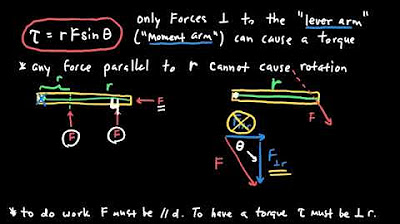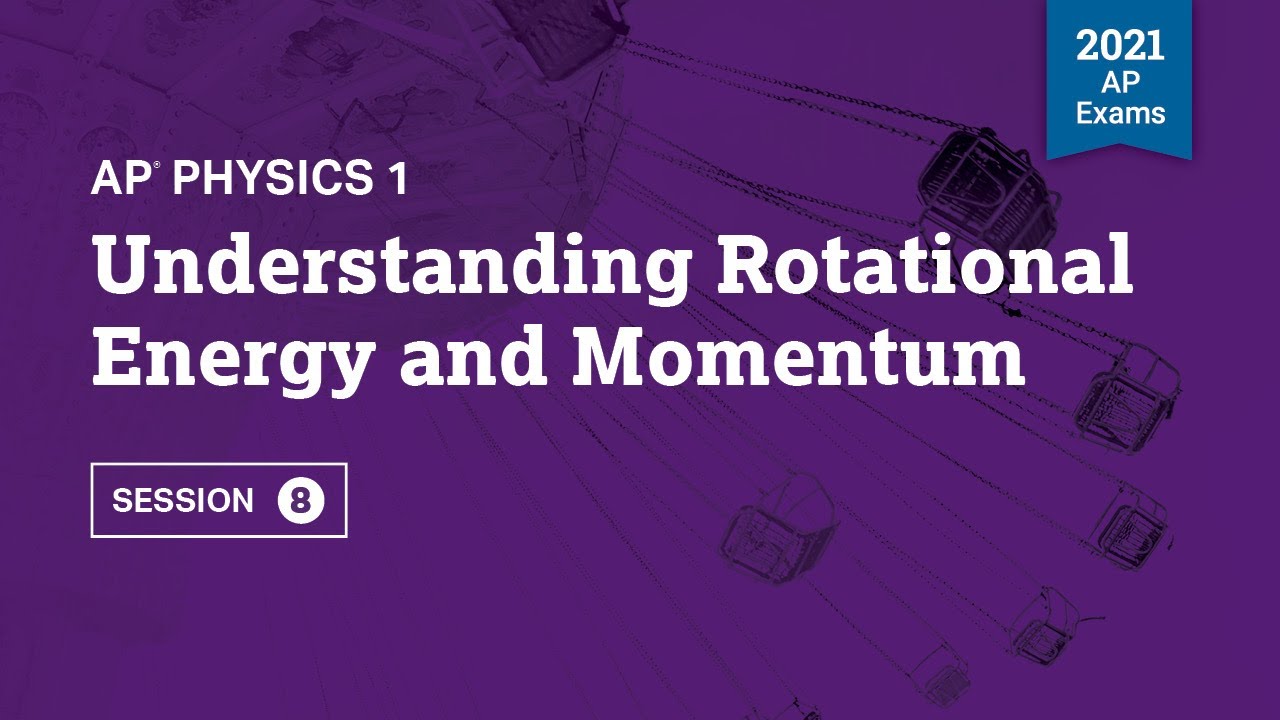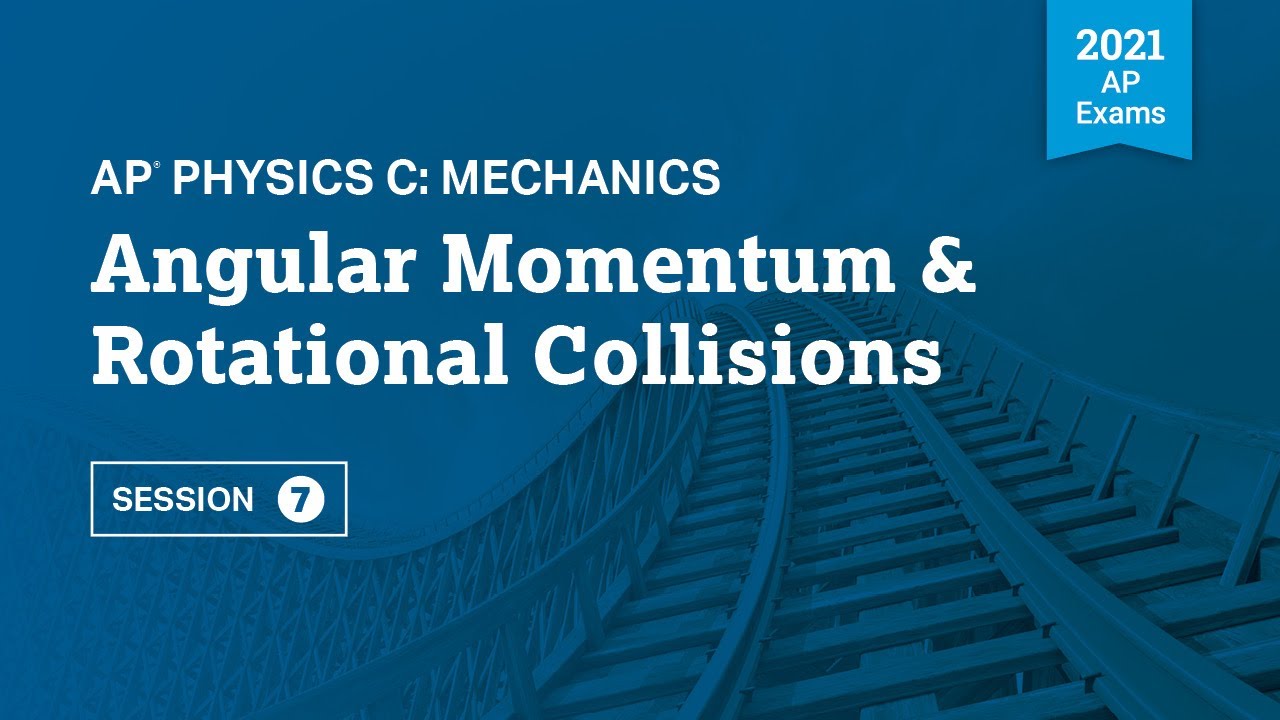2022 Live Review 6 | AP Physics C: Mechanics | Rotational Dynamics and Angular Momentum
TLDRIn this AP Physics C Mechanics live review, Julie Hood explores rotational dynamics, energy, and angular momentum. She covers the analogy between fixed-axis rotation and linear motion, applying conservation principles to systems like rolling bodies on inclines. The session includes practice with moments of inertia, energy conservation in rotational motion, and solving problems using old AP exam questions. The importance of understanding concepts like torque, angular acceleration, and the conservation of angular momentum is emphasized for success in the AP exam.
Takeaways
- 📚 The session is a review of AP Physics C Mechanics, focusing on rotational dynamics, energy, and angular momentum, which are the instructor's favorite topics.
- 🔧 Newton's second law is applicable to rotational motion as well, where net torque results in angular acceleration of a mass distribution with moment of inertia.
- 📐 Moment of inertia is calculated by summing the product of each mass element and its square of the distance from the axis of rotation, and can be calculated using the parallel axis theorem or integral calculus.
- ⚙️ The conservation of energy principle is applied to systems like rolling bodies on inclines, where kinetic energy is converted into gravitational potential energy.
- 🌀 Angular momentum, represented by \( L \), is conserved in the absence of external torque, similar to linear momentum \( p \) being conserved without external force.
- 🏆 The instructor encourages students to review old exams and scoring rubrics available on AP Central to understand what the college board looks for in exam responses.
- 🧩 The session includes solving multiple-choice and free-response questions from past exams to practice the concepts of rotational dynamics and energy conservation.
- 📉 The conservation of energy is used to find the vertical height a bowling ball reaches when rolling up an incline, by equating initial kinetic and potential energy to the final potential energy.
- 🔄 The effects of moment of inertia on rolling objects are illustrated through problems involving solid spheres, hollow spheres, and other shapes, showing how different moments of inertia affect motion.
- 🧲 Friction plays a crucial role in rotational motion; without it, objects would not rotate, and with it, rotational kinetic energy is considered in energy conservation problems.
- 🎭 The 'ice skater' problem, a recurring type in AP exams, demonstrates the conservation of angular momentum when a figure skater pulls their arms in during a spin, leading to an increase in rotational speed and kinetic energy.
- 🧬 The session concludes with an experiment involving a falling rod to derive an expression for the velocity of its free end and to experimentally determine the acceleration due to gravity, emphasizing the application of theoretical concepts in practical scenarios.
Q & A
What is the primary focus of the AP Physics C Mechanics live review session presented by Julie Hood?
-The primary focus of the session is on rotational dynamics, energy, and angular momentum, including the analogy between fixed-axis rotation and linear translation, the concept of rotational inertia, and the application of conservation of energy and angular momentum principles to various physical systems.
How can students find multiple-choice and free-response questions from previously released exams for AP Physics C Mechanics?
-Students can find these questions by searching 'AP Central Physics C Mechanics' on Google, and adding 'free response' to directly access the page with exams dating back to 1999, along with their scoring rubrics.
What is the relationship between Newton's second law and rotational motion?
-Newton's second law, which states F = ma for linear motion, has a rotational counterpart. If there is a net torque acting on a mass distribution (represented by I, the moment of inertia), the mass will angularly accelerate.
How is moment of inertia defined in the context of the script?
-Moment of inertia (I) is defined as the sum of the product of every piece of mass in the object and its respective distance squared from the axis of rotation.
What is the parallel axis theorem and how is it used in the script?
-The parallel axis theorem is used to calculate the moment of inertia of a system when the axis of rotation is not through the center of mass but at a distance d away from it. It allows adjusting the moment of inertia calculated around the center of mass to account for this offset.
How does the conservation of energy principle apply to objects rolling down inclines?
-The conservation of energy principle states that the total energy of a closed system remains constant. For objects rolling down inclines, the initial gravitational potential energy is converted into both translational and rotational kinetic energy, and possibly gravitational potential energy at a new height.
What is the relationship between linear momentum (p) and angular momentum (L)?
-Linear momentum (p) is given by the product of mass (m) and linear velocity (v), i.e., p = mv. Angular momentum (L) is its rotational analog and is given by the product of the moment of inertia (I) and angular velocity (ω), i.e., L = Iω. Both are conserved quantities in the absence of external forces or torques.
How does the moment of inertia affect the speed of a rolling object reaching the bottom of an incline?
-The moment of inertia affects the speed of a rolling object because it determines the amount of rotational kinetic energy. A larger moment of inertia means more energy is stored rotationally, leaving less energy for translational motion, thus affecting the final speed at the bottom of the incline.
What is the significance of the ice skater problem in understanding conservation of angular momentum?
-The ice skater problem demonstrates the conservation of angular momentum when the skater pulls their arms in from an extended position to their side during a spin. The decrease in moment of inertia (due to mass coming closer to the axis of rotation) results in an increase in angular velocity to conserve angular momentum.
How can the conservation of linear and angular momentum be used to determine the outcome of a collision between a disk and a rod on a horizontal surface?
-In a collision between a disk and a rod on a horizontal surface with negligible friction, both linear and angular momenta are conserved. This means that before and after the collision, the total linear momentum (related to the motion of the center of mass) and the total angular momentum (related to the rotational motion about a point) remain unchanged, allowing us to predict the motion of the system post-collision.
What is the role of integral calculus in calculating the moment of inertia for a non-uniform object or complex shape?
-Integral calculus is used to calculate the moment of inertia for non-uniform objects or complex shapes by summing up the contributions of all small mass elements (dm) at their respective distances squared (r^2 dm) from the axis of rotation, which is expressed as the integral ∫r^2 dm.
How does the script demonstrate the use of Newton's second law in rotational motion?
-The script demonstrates that Newton's second law, which relates force, mass, and acceleration in linear motion, has a rotational equivalent. When there is a net torque acting on an object, it results in angular acceleration, with the relationship described by τ = Iα, where τ is the net torque, I is the moment of inertia, and α is the angular acceleration.
What experimental method is suggested in the script to verify the theoretical equation for the velocity of the free end of a falling rod?
-The script suggests using photo gates to measure the velocity of the free end of rods of different lengths as they fall, and then linearizing the data to find a straight-line relationship between velocity and the square root of the rod length, from which the acceleration due to gravity (g) can be determined.
How can the effects of air resistance be reduced in the experiment involving falling rods, as mentioned in the script?
-The script suggests reducing air resistance effects by possibly conducting the experiment in a vacuum, using shorter or more massive rods, or employing rods with a more aerodynamic shape, such as a circular cross-section instead of square or rectangular.
Outlines
📚 Introduction to Rotational Dynamics and AP Physics C Mechanics Review
Julie Hood, a physics teacher, introduces the topic of rotational dynamics in the context of AP Physics C Mechanics. She outlines the lesson plan, which includes an analogy between fixed-axis rotation and linear translation, the concept of rotational inertia, and the application of conservation principles to rolling bodies and inclined systems. The session also covers multiple-choice and free-response questions from past exams, encouraging students to explore AP Central for resources. The importance of understanding Newton's second law in the context of rotational motion is highlighted, with a brief introduction to moment of inertia and its calculation.
🎳 Application of Conservation Laws to Rolling Bodies on Inclines
The paragraph delves into the application of the conservation of energy principle to a bowling ball rolling up an incline. It explains how the ball's kinetic energy, both translational and rotational, is converted into gravitational potential energy. The relationship between linear velocity and angular velocity is used to solve for the height the ball reaches. The paragraph also discusses scenarios with and without friction, emphasizing the conservation of energy and the irrelevance of additional data when the system is frictionless. The solution involves algebraic manipulation and understanding of rotational kinetic energy.
🔄 Comparing Moment of Inertia and Energy Conservation in Different Objects
This section compares the motion of a ring and a disc up an incline, focusing on their moment of inertia and how it affects their ability to move up the incline. It explains that the ring, having a larger moment of inertia, will move further up the incline due to the conservation of energy. The paragraph also discusses a system with two connected masses passing over a pulley with friction, deriving the equation for the pulley's rotational motion. Lastly, it addresses a cylinder with constant angular acceleration, calculating angular acceleration, angular momentum, and kinetic energy at a specific time.
🏒 Angular Momentum and Kinetic Energy in an Ice Skater's Spin
The paragraph explores the conservation of angular momentum in the context of an ice skater bringing their arms from an extended position to their side during a spin. It explains that the moment of inertia decreases when the arms are brought in, leading to an increase in angular velocity and kinetic energy. The paragraph emphasizes the importance of recognizing that angular momentum remains constant during the skater's motion and how this principle narrows down the possible answers to a question about the skater's motion.
🚀 Collision Dynamics and Conservation of Momentum and Energy
This section discusses a scenario where a disk slides on a horizontal surface and collides with a rod that is free to move and rotate. It highlights the conservation of linear and angular momentum during the collision and notes that kinetic energy is not conserved unless specified as a perfectly elastic collision. The paragraph also examines a situation where two identical disks collide, and one sticks to the other, resulting in a decrease in the system's angular speed due to the increase in moment of inertia.
📐 Free Body Diagram and Energy Conservation for a Sphere on an Incline
The paragraph introduces a problem involving a solid sphere rolling down an incline, requiring the construction of a free body diagram and the application of energy conservation principles. It explains the forces involved, such as gravitational force, normal force, and frictional force, and how they relate to the sphere's motion. The paragraph then uses the conservation of energy to derive an expression for the sphere's translational speed at the bottom of the incline, taking into account the sphere's moment of inertia and the relationship between linear and angular velocities.
🔄 Moment of Inertia and Acceleration of Different Objects on an Incline
This section compares the motion of different objects, such as a solid sphere, a hollow sphere, and a ring, as they roll down an incline. It discusses how the moment of inertia affects the translational speed and acceleration of these objects, with the solid sphere having the highest velocity and acceleration due to its lowest moment of inertia. The paragraph also calculates the frictional force acting on the sphere and determines the minimum coefficient of friction required for rolling without slipping.
🔢 Experimentation and Calculation of Gravitational Acceleration
The paragraph describes an experiment involving a bar pivoted at one end and falling freely to calculate the velocity at the free end when vertical. It uses integral calculus to determine the bar's moment of inertia and conservation of energy to derive an expression for the velocity. The paragraph then outlines the experimental setup, data collection using photo gates, and the process of linearizing data to find the acceleration due to gravity. It also discusses potential sources of error and ways to reduce air resistance in the experiment.
📚 Summary of Key Concepts in Rotational Dynamics
The final paragraph summarizes the key concepts covered in the video, emphasizing the importance of energy conservation, rotational kinetic energy, moment of inertia, and the conservation of angular momentum in solving rotational motion problems. It also highlights the use of Newton's second law in rotational contexts and the methods for calculating moment of inertia, such as the parallel axis theorem and integral calculus. The paragraph encourages students to practice with old exams and review materials to prepare for the AP Physics C Mechanics exam.
Mindmap
Keywords
💡Rotational Dynamics
💡Energy Conservation
💡Angular Momentum
💡Moment of Inertia
💡Torque
💡Parallel Axis Theorem
💡Incline
💡Kinetic Energy
💡Gravitational Potential Energy
💡Friction
Highlights
Introduction to rotational dynamics, energy, and angular momentum as key topics in AP Physics C Mechanics.
Analogy between fixed-axis rotation and linear translation for objects subject to torques.
Application of conservation of energy principles to systems such as rolling bodies on inclines.
Explanation of the law of conservation of angular momentum and its importance.
Practical guidance on finding resources for AP Physics C Mechanics, including past exams and scoring rubrics.
Review of Newton's second law and its relation to rotational motion and torque.
Discussion on moment of inertia, its calculation, and the parallel axis theorem.
Use of integral calculus for calculating moment of inertia of continuous mass distributions.
Analysis of energy conservation applied to objects rolling down inclines with examples.
Problem-solving approach using conservation of energy for a bowling ball on an incline.
Differentiation between scenarios with and without friction and their effects on rotational motion.
Comparison of moment of inertia and its impact on the motion of a ring versus a solid disc on an incline.
Derivation of the equation describing the rotational motion of a pulley system.
Calculation of angular acceleration, angular momentum, and kinetic energy for a rotating cylinder.
Ice skater problem illustrating the conservation of angular momentum and its effects on kinetic energy.
Collision problem involving a disk and a rod, and the conservation of linear and angular momentum.
Experiment involving a falling rod to derive an expression for the velocity of its free end and to find the acceleration due to gravity.
Use of integral calculus to find the moment of inertia of a rod pivoted at one end.
Linearization of experimental data to determine the acceleration due to gravity with reduced error.
Suggestions for reducing air resistance in experiments for increased accuracy.
Summary of key concepts including energy conservation, rotational kinetic energy, and moment of inertia.
Encouragement to practice with old exams and use AP resources for better understanding and exam preparation.
Transcripts
Browse More Related Video

AP Physics 1 Torque and Rotational Motion Review

2021 Live Review 8 | AP Physics 1 | Understanding Rotational Energy and Momentum

2021 Live Review 7 | AP Physics C: Mechanics | Angular Momentum & Rotational Collisions

AP Physics 1 - 10 Minute Recap

AP Physics 1 review of Torque and Angular momentum | Physics | Khan Academy

AP Physics 1: Rotational Dynamics Review
5.0 / 5 (0 votes)
Thanks for rating: